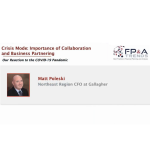This article provides a working model for businesses eager to transform a typical volume-intensive, cost-focused Shared...

In an age where everything is being more classified, defined and formalised, Financial Planning and Analysis (FP&A) is among the most rapidly developing functions within a corporate landscape. What once was a slim element of a toolkit within a typical accountant’s day-to-day routine has evolved into an essential specialisation in any organisational framework.
As with any emerging trend, companies, recruiters, and trainers alike begin to adopt industry buzzwords, buzz terms and concepts. Everyone tries to talk the lingo to attract highly skilled candidates or promote people to companies hungry for this ever-developing specialisation.
There are many new buzz terms in FP&A that can get candidates and prospective employers excited. Predictive Modelling, Driver-Based Budgeting, and Long-Range Planning are just a few examples of techniques, concepts or processes that have earned buzz over the last couple of decades.
Despite the excitement around the development of FP&A practices within many organisations, there is still a lot to learn. Both practitioners and organisations seek how to add value.
The term ‘FP&A Partnership’ is still a very new concept and can mean different things to different people. This term can easily become a buzzword like the ones mentioned earlier. Many people in our profession like to “talk the talk” when it comes to these “buzz” terms.
Some FP&A teams are more like a ‘Centre of Excellence’ (COE) model where the FP&A team sits and works together. The work they do is more of a one-off analysis-based exercise or event (e.g. budget or monthly/quarterly forecast-based), and, with more of a 3rd party view of the business, they act as record keepers for budgets and forecasts or a quasi-management reporting function.
Understanding the difference between a COE model and a true ‘Partnership Model’ is crucial for FP&A practitioners and managers. Depending on the size and needs of a company, one model may be more appropriate than the other. A true Partnership Model is when a company really begins to unlock value and synergy, which is often harder to obtain from a COE model.
While the COE model adds value to an organisation, it is not a true FP&A Partnership Model. In a genuine Partnership Model, there is usually an FP&A professional embedded within a function or a few different functions as a dedicated member of that/those functional team(s). They still have a solid line-reporting relationship with the central FP&A Director/Manager. Simultaneously, they have a very strong dotted-line relationship with the functional leader.
Traits of an FP&A Partnership Model
Dedicated Embedded FP&A Team Member
Every function has either a shared or dedicated member that will sit in the same area of the office as that functional team. In companies with hybrid work models, these members come in the same day as the functional team they support. They have to attend all functional team meetings and act like the right hand of the functional leader. Their day-to-day priorities are mostly set by that functional leader. They act as a liaison between that function and the accounting centre of a company, ensuring a smooth month-end is managed for that function and that all transactional requirements are met by the accounting centre for that unit.
Shared Ownership Mentality between the Functional Owner and the FP&A Practitioner
They not only take shared ownership of forecasts and budgets but also take a shared ownership position of how the results come in versus those budgets and forecasts. Often, in a COE model, the FP&A team act merely as a reporting conduit for the results. Encouraging the ownership mentality will increase engagement between the FP&A member and ownership of the forecasts/targets from the functional leader. Targets too often end up being set separately through a COE FP&A function, which sows the seeds for a lack of accountability from both the FP&A practitioner and the functional owner for those targets and actual results to match.
Functional Expertise
Due to the nature of a closer relationship, the FP&A practitioner becomes an expert on all things related to that function. They are more familiar with the processes, the inner workings of the transactions, and how costs and demand react to certain actions taken by the business within that function. This has several positive by-products:
- a) the FP&A practitioner is better positioned to find more hidden value-adding opportunities because they understand the nuances within that function;
- b) they are often best positioned to backfill key vacancies within that function, acting as a great bench strength alternative for the function; and
- c) acting as a great development path for the FP&A practitioner.
Decision Support and Decision Quality Control
While FP&A will always be a source of decision support regardless of the model, the fact that the member can be embedded into a function better positions them for quality and frequency of the decision support with the functional leader. The embedded nature of this relationship provides a higher form of transparency into the decisions being made, ensuring they are being made in a measured manner.
Difficulties in Establishing a Partnership Model
There are several hurdles an FP&A manager or practitioner may encounter when trying to establish and grow the partnership model.
- The business members/leaders within a particular function may not like the transparency provided by the embedded nature of the Partnership Model. As a result, they can keep the FP&A practitioner out of several team meetings and only involve them sparingly when they absolutely have to or for support on transactions with the accounting centre.
- The business or practitioners may not have the experience of a true Partnership Model. They can gravitate more towards the “as needed” basis, which is more of a COE model rather than the embedded basis where unrealised needs are uncovered as the practitioner and function interact daily.
- In the modern era of hybrid and remote working, the term “embedded” has become very relative. In a remote working model, it is much harder to embed a person who might not always be seen as a natural member of a functional team. Whereas in an “on-site” era or business, it was much easier to embed FP&A members just by co-locating them with their partner function.
- The size of the business may not warrant multiple FP&A practitioners, making it tricky as a business scales upward, where and when is the right time to add FP&A members, as well as when to move away from the COE model to more of the embedded partnership.
These definite hurdles to establishing and growing an effective FP&A Partnership Model are not impossible to overcome.
Walking the Walk: Making It Happen
Attitude, skill, and experience-related issues can be managed with effective training and good communication, leaving alone strong management tact and determination. Many of the walls put up by transparency-shy business leaders can often be broken down by establishing common goals and benefits with those people. We have to demonstrate that the FP&A practitioner is not there to be an interloper towards their everyday business but a mere compliment and a solution to them.
A good FP&A manager will document and share the differences in behaviour sought from the functional team and the practitioners and continue to monitor and coach both. Factor in training where they see it is appropriate. It can often take time, patience, discipline, and willpower to get the business teams and the practitioners to a level of understanding for this model to work at its height.
Affordability in terms of how many members a business can justify in FP&A can also be a hurdle. The best way to handle it is to look for the functions most needing that help and most likely to have opportunities uncovered by that sort of work. The more opportunities are uncovered, the more it will justify replicating that model in other functions.
I was lucky to have begun my career in a large company where affordability was not an issue. It allowed me to develop in an environment with many opportunities to show value from an FP&A perspective and see many different levels of the partnership between FP&A and different business functions in practice.
The truth I have taken from every experience in my career is that the FP&A function is ever-evolving. There are no shortages of opportunities available in any business to contribute towards its growth, especially when using a true FP&A Partnership Model.
Subscribe to
FP&A Trends Digest

We will regularly update you on the latest trends and developments in FP&A. Take the opportunity to have articles written by finance thought leaders delivered directly to your inbox; watch compelling webinars; connect with like-minded professionals; and become a part of our global community.






